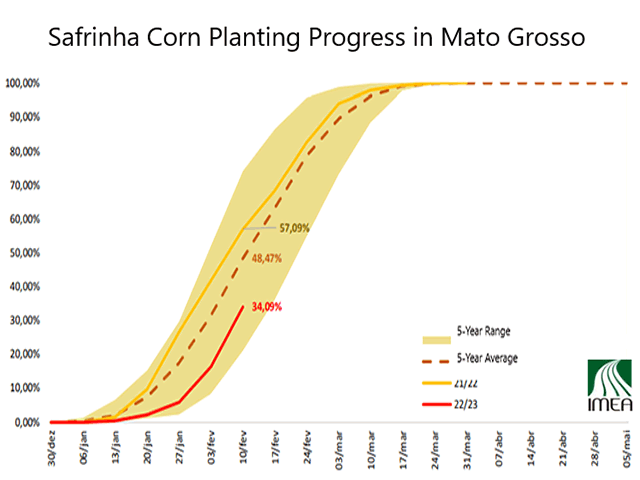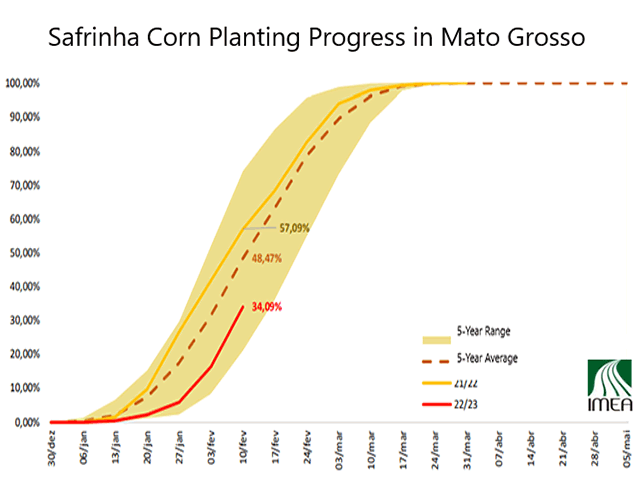South America Calling
Is It Time to Start Worrying About Brazil's Safrinha Corn Crop?
Brazil's soybean crop has not faced many challenges to production this year. But heavy rainfall over the major production areas for the last few weeks has led to major delays to harvest. With the second-season (safrinha) corn to be immediately planted after soybeans are harvested, the delays are also hitting corn planting. Concern is growing about the ability for a delayed safrinha crop to make the production numbers that are forecast.
Brazil has an incredible ability to plant two full-season crops back-to-back in the same marketing year. Being so close to the equator, Brazil does not have a true winter and summer. Average daytime high temperatures hover in the middle 80s to lower 90s Fahrenheit all year long. Instead, they have a distinct wet season and dry season. The wet season rains typically start up in late September and early October, and soybeans are planted as soon as there is enough moisture in the soil to do so.
The wet season truly is wet with near-daily showers and thunderstorms during the peak season. In the state of Mato Grosso, Brazil's most productive state for corn and soybeans, rainfall averages of 180 to 250 millimeters (roughly 7 to 10 inches) each month between November and March. Some areas of the state average more than that.
P[L1] D[0x0] M[300x250] OOP[F] ADUNIT[] T[]
Planting on time, which occurred this year despite a tendency for a delay due to La Nina, typically leads to harvest of a good soybean crop in January and February with the safrinha corn planting occurring immediately following. During a typical year, the primary planting window closes the third week of February to ensure corn gets through pollination before the wet season rains shut down and the heat increases the moisture demand for the corn. By getting through pollination with rain, the abundant subsoil moisture that built up during the season is usually enough for grain fill and a profitable crop.
The dry season typically sets in the first few days of May on average and is nearly completely dry. Rainfall averages less than 50 mm (roughly 2 inches) each month between May and September. June, July, and August are nearly rain-free with less than 20 mm (0.8 inches) each month. Trying to get through both pollination and grain fill with only subsoil moisture to work with usually is not enough. Beyond the soil moisture problems, delayed planting also puts the crop at risk of frosts that may occur in June while the crop may still be filling. That risk is heightened during a La Nina season.
During the last two safrinha seasons, we have seen the impacts that La Nina has brought to a safrinha crop. In 2021, soybeans were planted late and so was safrinha corn. Corn production suffered under the weight of a shortened wet season when rains shut down in mid-April, leaving the crop with little soil moisture through much of its development. Crop production estimates declined each time a new update was produced, leaving the country with about 80% of its original production estimate. In 2022, safrinha corn was planted slightly ahead of schedule as producers noted the problems that La Nina brought the previous year. While the rains shut down again in mid-April, the safrinha crop was able to cope with the drier weather due to earlier planting. Production was higher than the previous year, though slightly lower than the original estimate from the USDA.
This year started to match last year. Corn production estimates were aggressive with an increase of 8.6% during the 2021-22 season. The soybean crop went in on time and wet season rains were generally favorable. However, they have become too favorable. Heavy deluges from Parana to Mato Grosso to Minas Gerais have limited the ability for producers to get into the fields, harvest their soybeans, ship their beans to port, and plant the safrinha corn.
According to the Mato Grosso Institute of Agricultural Economy (IMEA), as of Feb. 10, only 34% of Mato Grosso's corn has been planted, compared to 48% on average and 57% last year. That is an increase of almost 18% from last week, and largely due to some better windows for getting work done. But with those windows now limited and a forecast for more heavy rain during the next two weeks, the ability for producers to make up ground will be hard to accomplish. If they are unable to do so, the end of the wet season will be closely monitored for production issues. Long-range models and forecasts from DTN point to lower rainfall amounts in central Brazil for March and a shortened wet season in April, an unfavorable outlook for a delayed safrinha corn crop.
To find more international weather conditions and your local forecast from DTN, visit https://www.dtnpf.com/….
John Baranick can be reached at john.baranick@dtn.com
(c) Copyright 2023 DTN, LLC. All rights reserved.





Comments
To comment, please Log In or Join our Community .